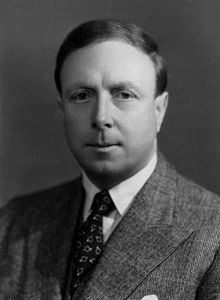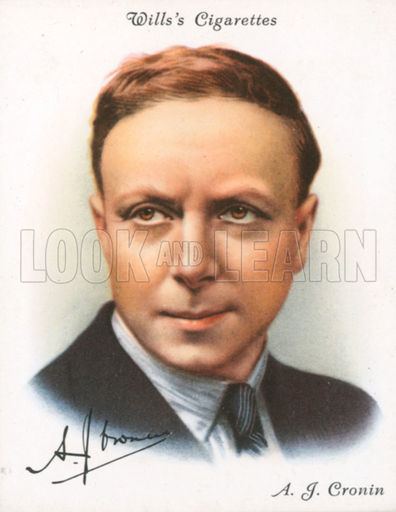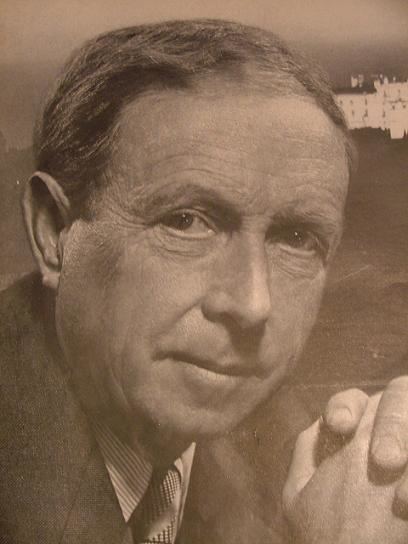Name A. Cronin | Role Novelist | |
 | ||
Awards National Book Award for Fiction Parents Patrick Cronin, Jessie Cronin Books The Citadel, Hatter's Castle, The Keys of the Kingdom, The Stars Look Down, The Green Years Similar People | ||
Birth by a j cronin
Archibald Joseph Cronin, MBChB, MD, DPH, MRCP (19 July 1896 – 6 January 1981) was a Scottish novelist and physician.
Contents
- Birth by a j cronin
- Early life
- Medical career
- Writing career
- Influence of The Citadel
- Religion
- Family
- Later years
- Honours
- Selected periodical publications
- Film adaptations
- Selected television credits
- Selected radio credits
- References

His best-known novel is The Citadel (1937), the story of a doctor from a Welsh mining village who quickly moves up the career ladder in London. Cronin had observed this scene closely as a Medical Inspector of Mines and later as a doctor in Harley Street. The book promoted what were then controversial new ideas about medical ethics and helped to inspire the launch of the National Health Service. Another popular mining novel of Cronin's, set in the North East of England, is The Stars Look Down. Both these novels have been adapted as films, as have Hatter's Castle, The Keys of the Kingdom and The Green Years. Cronin's novella Country Doctor was adapted as a long-running BBC radio and TV series Dr Finlay's Casebook, revived many years later.

Early life
Cronin was born in Cardross, Scotland, the only child of a Protestant mother, Jessie Cronin (née Montgomerie), and a Catholic father, Patrick Cronin. Cronin often wrote of young men from similarly mixed backgrounds. His paternal grandparents had emigrated from County Armagh, Ireland, and become glass and china merchants in Alexandria. Owen Cronin, his grandfather, had had his surname changed from Cronague in 1870. His maternal grandfather, Archibald Montgomerie, was a hatter who owned a shop in Dumbarton. After their marriage Cronin's parents moved to Helensburgh, where he attended Grant Street School. When he was seven years old, his father, an insurance agent and commercial traveller, died from tuberculosis. He and his mother moved to her parents' home in Dumbarton, and she soon became a public health inspector in Glasgow
Cronin was not only a precocious student at Dumbarton Academy who won many prizes in writing competitions, but also an excellent athlete and footballer. From an early age he was an avid golfer, and he enjoyed the sport throughout his life. He also loved salmon fishing.
The family later moved to Yorkhill, Glasgow, where Cronin attended St Aloysius' College in the Garnethill area of the city. He played football for the First XI there, an experience he included in one of his last novels, The Minstrel Boy. A family decision that he should study either to join the church or to practise medicine was settled by Cronin himself when he chose "the lesser of two evils". He won a Carnegie scholarship to study medicine at the University of Glasgow in 1914. He was absent in 1916–1917 for naval service. In 1919 he graduated, with highest honours, with the degree of MBChB. Later that year he made a trip to India as ship's surgeon on a liner. Cronin went on to earn additional qualifications, including a Diploma in Public Health (1923) and his MRCP (1924). In 1925 he was awarded an MD by the University of Glasgow for his dissertation, entitled "The History of Aneurysm".
Medical career
During the First World War Cronin served as a surgeon sub-lieutenant in the Royal Navy Volunteer Reserve before graduating from medical school. After the war he trained at various hospitals, including Bellahouston and Lightburn Hospitals in Glasgow, and the Rotunda Hospital in Dublin. He undertook general practice in a small village on the Clyde, Garelochhead, as well as in Tredegar, a mining town in South Wales. In 1924 he was appointed Medical Inspector of Mines for Great Britain, and his survey of medical regulations in collieries, and his reports on the correlation between coal dust inhalation and pulmonary disease, were published over the next few years. He was involved in the disaster at Ystfad Colliery in Pengelly, where thirty-eight miners were drowned and the remaining twenty-three were rescued after eight days. Cronin drew on this haunting experience and his research on the occupational hazards of the mining industry for his later novels The Citadel, set in Wales, and The Stars Look Down, set in Northumberland. He subsequently moved to London, where he practised in Harley Street before opening his own thriving medical practice in Notting Hill. Cronin was also the medical officer for Whiteleys at this time and was becoming increasingly interested in ophthalmology.
Writing career
In 1930 Cronin was diagnosed with a chronic duodenal ulcer and was told that he must take six months' complete rest in the country on a milk diet. At Dalchenna Farm by Loch Fyne he was finally able to indulge his lifelong desire to write a novel, having previously "written nothing but prescriptions and scientific papers". From Dalchenna Farm he travelled to Dumbarton to research the background of his first novel, using the files of Dumbarton Library, which still has the letter from Cronin requesting advice. He composed Hatter's Castle in the span of three months, and the manuscript was quickly accepted by Gollancz, the only publishing house to which it had been submitted (it was apparently chosen when his wife randomly stuck a pin into a list of publishers). This novel, which was an immediate and sensational success, launched Cronin's career as a prolific author, and he never returned to practising medicine.
Many of Cronin's books were bestsellers in their day and have been translated into many languages. Some of his stories draw on his medical career, dramatically mixing realism, romance and social criticism. Cronin's works examine moral conflicts between the individual and society, as his idealistic heroes pursue justice for the common man. One of his early novels, The Stars Look Down (1935), chronicles transgressions in a mining community in Northeast England and an ambitious miner's rise to be a Member of Parliament.
A prodigiously fast writer, Cronin liked to average 5,000 words a day, meticulously planning the details of his plots in advance. He was known to be tough in business dealings, although in private life he was a person whose "pawky humour ... peppered his conversations," according to one of his editors, Peter Haining.
Cronin also contributed many stories and essays to various international publications. During the Second World War he worked for the British Ministry of Information, writing articles as well as participating in radio broadcasts to foreign countries.
Influence of The Citadel
The Citadel (1937), a tale of a mining company doctor's struggle to balance scientific integrity with social obligations, helped to incite the establishment of the National Health Service (NHS) in the United Kingdom by exposing the inequity and incompetence of medical practice at the time. In the novel Cronin advocated a free public health service in order to defeat the wiles of those doctors who "raised guinea-snatching and the bamboozling of patients to an art form." Dr Cronin and Aneurin Bevan had both worked at the Tredegar Cottage Hospital in Wales, which served as one of the bases for the NHS. The author quickly made enemies in the medical profession, and there was a concerted effort by one group of specialists to get The Citadel banned. Cronin's novel, which was the highest-selling book ever published by Victor Gollancz, informed the public about corruption within the medical system, planting a seed that eventually led to reform. Not only were the author's pioneering ideas instrumental in the creation of the NHS, but the historian Raphael Samuel asserted in 1995 that the popularity of Cronin's novels played a substantial role in the Labour Party's landslide victory in 1945.
By contrast, according to one of Cronin's biographers, Alan Davies, the book's reception was mixed. A few of the more vociferous medical practitioners of the day took exception to one of its many messages: that a few well-heeled doctors in fashionable practices were ripping off their equally well-off patients. Some pointed to the lack of balance between criticism and praise for hard-working doctors. The majority accepted it for what it was, a topical novel. The press attempted to incite passions within the profession in an attempt to sell copy, while Victor Gollancz followed suit in an attempt to promote the book, all overlooking the fact that it was a work of fiction, not a scientific piece of research, and not autobiographical.
In the United States The Citadel won the National Book Award, Favorite Fiction of 1937, voted by members of the American Booksellers Association. According to a Gallup poll conducted in 1939, The Citadel was voted the most interesting book readers had ever read.
Religion
Some of Cronin's novels also deal with religion, which had grown away from during his medical training and career, but which he reacquainted himself with during the 1930s. At medical school, as he recounts in his autobiography, he had become an agnostic: "When I thought of God it was with a superior smile, indicative of biological scorn for such an outworn myth." During his practice in Wales, however, the deep religious faith of the people he worked among made him start to wonder whether "the compass of existence held more than my text-books had revealed, more than I had ever dreamed of. In short I lost my superiority, and this, though I was not then aware of it, is the first step towards finding God."
Cronin also came to feel that "If we consider the physical universe,... we cannot escape the notion of a primary Creator.... Accept evolution with its fossils and elementary species, its scientific doctrine of natural causes. And still you are confronted with the same mystery, primary and profound. Ex nihilo nihil, as the Latin tag of our schooldays has it: nothing can come of nothing." This was brought home to him in London, where in his spare time he had organized a working boys' club. One day he invited a distinguished zoologist to deliver a lecture to the members. The speaker, adopting "a frankly atheistic approach," described the sequence of events leading to the emergence, "though he did not say how," of the first primitive life-form from lifeless matter. When he concluded, there was polite applause. Then, "a mild and very average youngster rose nervously to his feet" and with a slight stammer asked how there came to be anything in the first place. The naïve question took everyone by surprise. The lecturer "looked annoyed, hesitated, slowly turned red. Then, before he could answer, the whole club burst into a howl of laughter. The elaborate structure of logic offered by the test-tube realist had been crumpled by one word of challenge from a simple-minded boy."
Family
It was at university that Cronin met his future wife, Agnes Mary Gibson (May) (1898–1981), who was also a medical student. She was the daughter of Robert Gibson, a master baker, and Agnes Thomson Gibson (née Gilchrist) of Hamilton, Lanarkshire. The couple married on 31 August 1921. As a physician, May worked with her husband briefly in the dispensary while he was employed by the Tredegar Medical Aid Society; she also assisted him with his practice in London. When he became an author, she would proofread his manuscripts. Their first son, Vincent, was born in Tredegar in 1924. Their second son, Patrick, was born in London in 1926. Andrew, their youngest son, was born in London in 1937.
With his stories being adapted to Hollywood films, Cronin and his family moved to the United States in 1939, living in Bel Air, California; Nantucket, Massachusetts; Greenwich, Connecticut; and Blue Hill, Maine. In 1945, the Cronins sailed back to England aboard the RMS Queen Mary, where they stayed briefly in Hove and then in Raheny, Ireland before returning to the U.S. the following year. They subsequently took up residence at the Carlyle Hotel in New York City and then in Deerfield, Massachusetts before settling in New Canaan, Connecticut in 1947. Ever the nomad, Cronin also frequently travelled to his homes in Bermuda and Cap-d'Ail, France, where he summered.
Later years
Ultimately Cronin returned to Europe, to reside in Lucerne and Montreux, Switzerland, for the last 25 years of his life. He continued to write into his eighties. He included among his friends Laurence Olivier, Charlie Chaplin and Audrey Hepburn, to whose first son he was godfather.
Although the latter part of his life was spent entirely abroad, Cronin retained a great affection for the district of his childhood, writing in 1972 to a local teacher: "Although I have travelled the world over I must say in all sincerity that my heart belongs to Dumbarton. ... In my study there is a beautiful 17th-century coloured print of the Rock... I even follow with great fervour the fortunes of the Dumbarton football team." Further evidence of Cronin's lifelong support of Dumbarton F. C. comes from a framed typewritten letter hanging in the foyer of the club's stadium. In the letter, written in 1972 and addressed to the club's then secretary, Cronin congratulates Dumbarton on their return to the top division after an absence of 50 years and recalls his childhood supporting the Sons (the club's nickname) and on occasion being "lifted over" the turnstiles (a common practice in times past so that children did not have to pay).
Cronin died on 6 January 1981 in Montreux, and is interred at La Tour-de-Peilz. Many of Cronin's writings, including published an unpublished literary manuscripts, drafts, letters, school exercise books and essays, laboratory books, and his M.D. thesis, are held at the National Library of Scotland and at the Harry Ransom Center at the University of Texas.
